As is well documented, Van Gogh, shot himself, accidentally or intentionally.It was called a suicide. But, was his own physician partly to blame for his death? The end of Vincent Van Gogh, was indeed strange. ….
In 1947, Antonin Artaud, whose entire life had been a struggle between the sometimes conflicting and sometimes allied forces of madness and artistic expression, published a slim volume about a kindred spirit. It was entitled, “Van Gogh, The Man Suicided by Society”. The tone, that of barely controlled fury, seemed to derive from Artaud’s identification with the dead painter. Both had suffered from attacks of mental illness and committed to institutions for the insane, Van gogh for a year and Artaud for nine. Artaud’s indictment named as the villain in Van Gogh’s death the last doctor to treat him, Paul Ferdinand Gachet.
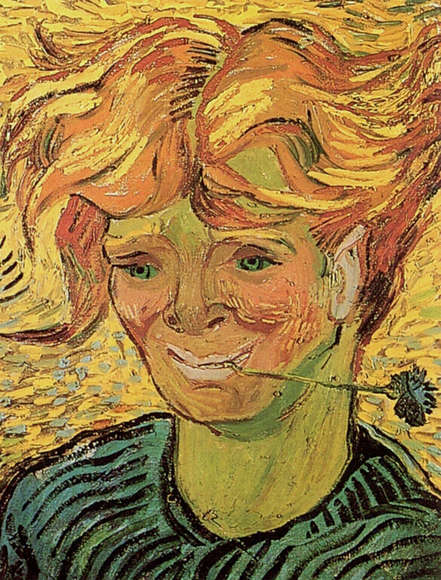
"Young Man with Cornflower", oil on canvas, 39.0 x 30.5 cm, June, 1890. Private collection, Dallas, USA.
“When I first read Artaud’s essay, van Gogh: The Man Suicided by Society, I was astonished by the intimacy. I was immediately struck by the power with which he explained van Gogh, his paintings and his psyche. It was as though Artaud had somehow tapped into Vincent van Gogh’s inner circuit of consciousness, his élan vital, and used the same language as the ill-fated painter. There is no question van Gogh was a genius, as Artaud so eloquently proved in his essay. However, the insights Artaud provides about madness and genius and his theories of suicide are quite remarkable on their own. “There are no ghosts in the paintings of van Gogh, no visions, no hallucinations. This is the torrid truth of the sun at two o’clock in the afternoon. A slow generative nightmare gradually becoming clear. Without nightmare and without result. But the suffering of the prenatal is there. It is the wet gleam of a meadow, of the stalk of a slip of wheat which is there to be extradited. And for which nature will one day answer. As society will also for his untimely death.”
I remember repeating the word ‘Brilliant’ in my head as I read Artaud’s reasoning, however misused that word has now become. The extraordinary narration of Artaud put van Gogh’s life and death into perspective for me. “Besides, one does not commit suicide by oneself. No one has ever been born by oneself. No one dies by oneself either.” He linked art with madness in a way I had previously never experienced, or thought possible.” ( Stephen R. Killeen)
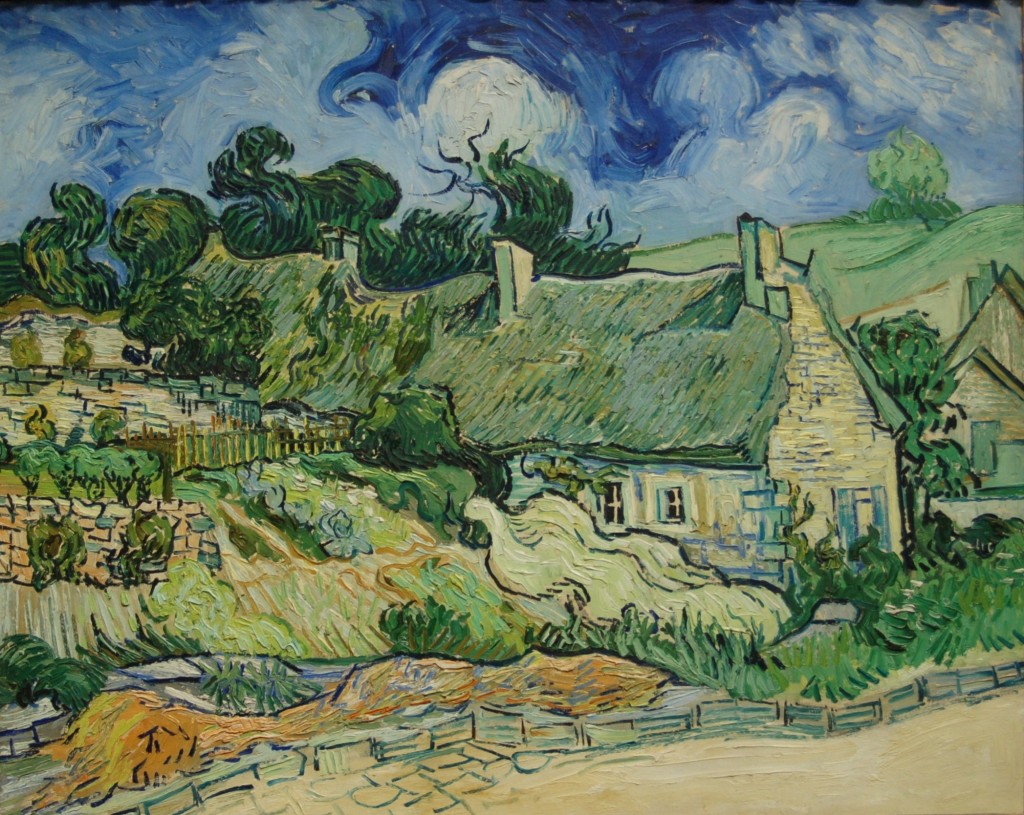
"Auvers is very beautiful", Vincent wrote his brother the day he arrived in town, and the beauty of its environs inspired seventy paintings in as many days, including Cottages at Cordeville.
…Vincent’s first impressions of Dr. Gachet were perceptive and prescient. “I have seen Dr. Gachet, who gives me the impression of being rather eccentric, but his experience as a doctor must keep him balanced enough to combat the nervous trouble from which he certainly seems to be suffering at least as seriously as I. ” Certainly, Dr. Gachet appeared the epitomy of resignation and despair. Van Gogh’s portrait of him shows the doctor staring with devastating pathos into the void. Gachet’s torment awakened his patient’s compassion. But Gachet, through his negligence, may have caused Van Gogh’s death….
An analysis of van Gogh’s illness and emotionality must not obscure the fact that the great artist also had great strengths . Apart from distinct episodes of madness when he used absinthe and had seizures, he maintained a remarkable degree of lucidity during his stormy life, as is well documented in his letters. Vincent was not in the habit of questioning the mental stability of the people he met, for he knew how precarious the balance of the mind could be. However, after a single meeting with Dr. Gachet, Van Gogh was convinced that he, too, was unbalanced.
..Given the multiplictiy of diagnoses, it is not clear if van Gogh suffered from a visual disorder and if so, its origins. Gachet may well have treated van Gogh for mania and/or epilepsy with digitalis. In the nineteenth century digitalis, extracted from the purple foxglove plant, was one of the main treatments for these disorders. It was used as a sedative, an anticonvulsant, and an anti-manic agent. Interestingly, on the only two occasions that van Gogh painted Doctor Gachet he was holding a foxglove plant . Was this van Gogh’s way of telling us that he suffered from the effects of digitalis poisoning at Doctor Gachet’s hand?
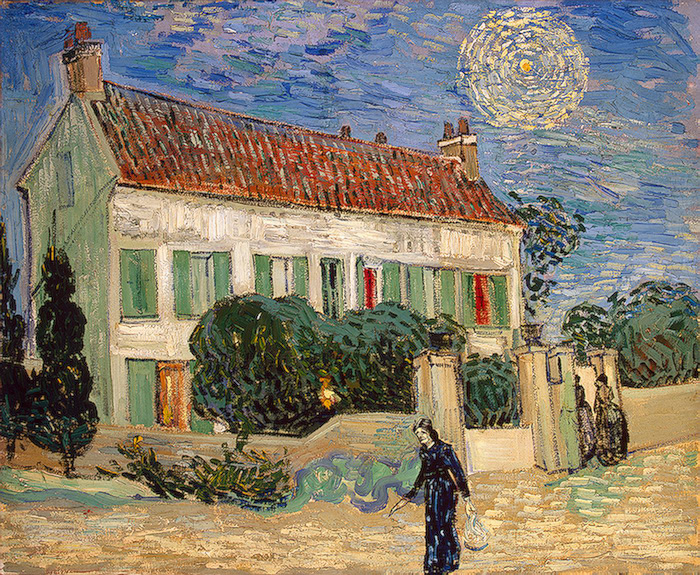
"...where van Gogh could live near Paul Gachet, a physician and friend of the artists. He abstained from drinking by now and remained free from seizures and confusional episodes. His art was beginning to gain recognition, and a painting had been sold. But further financial support became uncertain as Theo’s health began to fail. There were some bitter words between the brothers, and Vincent felt himself to be a burden. Still, he worked at a furious pace, completing 70 paintings and 30 drawings during his 70 days at Auvers. The heavenly bodies, so luminous in the past, now were absent from his skies, ex
for a single peculiar occasion (The White House at Night With Figures and a Star)"Dr. Gachet , who had a theory for everything, told Vincent Van Gogh that he understood his work by virtue of his own study of natural history. Vincent, as he saw it, was a Dutch Rousseau who celebrated nature, producing a form of peasant art made of wooden clogs that was nevertheless as refined as Japanese art. When he saw Vincent’s “Arlesienne” , Dr. Gachet, after some hesitation, exclaimed: “How difficult it is to be simple!” In the June 4 letter to brother Theo, Vincent mentioned Dr. Gachet’s pretty blonde daughter, Marguerite, for the first time: “I shall most probably also do the portrait of his daughter, who is nineteen years old, and with whom I would imagine Jo ( Theo’s wife Joanne ) would soon be friends.”
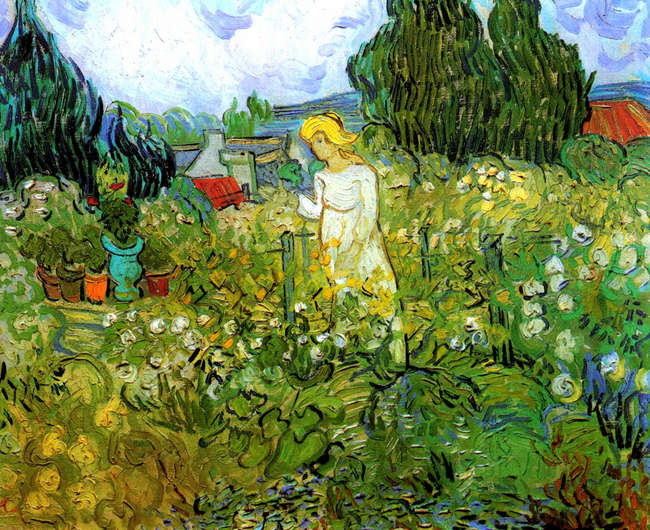
"Marguerite Gachet in the Garden", oil on canvas, 46.0 x 55.5 cm, June, 1890. Musée d’Orsay, Paris, France.
Vincent was feeling good and working well, like a highly volatile substance that a chemist has succeeded in stabilizing. “I also hope that this feeling I have of being much more master of my brush than before I went to Arles will last”, he wrote in the same letter. “And Mr. Gachet says that he thinks it most improbable that it ( his illness) will return, and that things are going on quite well. …Altogether, father Gachet is very, yes very like you and me. … I feel that he understands us perfectly and that he will work for you and me to the best of his power, without any reserve, for the love of art for art,s sake.” For Vincent, Dr. Gachet had become the indispensable man, the healer who understood him and made his work possible.
As for Dr. Gachet, he too was convinced that his curative powers were at work on Vincent. “Dr. Gachet came to see me yesterday,” Theo wrote his brother June 5, “but at any rate he told me that he thought you entirely recovered , and that he did not see any reason for a return of your malady”.
On June 8 Theo, Jo and their son came to Auvers to spend the day, and the infant Vincent played in Dr. Gachet’s yard with the numerous dogs, cats, chickens, pigeons, rabbits, and geese. It was a pleasant Sunday outing, with Vincent relaxed and surrounded by his real and surrogate families. In the days that followed, Vincent was so absorbed in his work that he did not write again until the end of June to describe a new portrait: “Yesterday and the day before, I painted Mlle. Gachet’s portrait, which I hope you will see soon; the dress is red, the wall in the background green with orange spots, the carpet red with green spots, the piano dark violet; it is forty inches high by twenty inches wide. It is a figure that I enjoyed painting- but it is difficult. He ( Gachet ) has promised to make her pose for me another time at the small organ.”
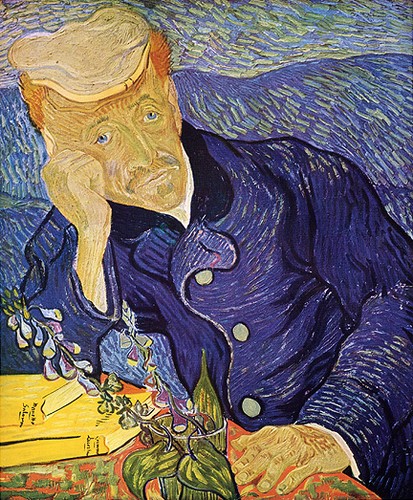
"Gachet seems sad in the portrait, leaning on his hand with a melancholy expression. It is said that the foxglove plant in Gachet’s hand suggests he was treating Vincent with the plant’s derivative digitalis. This drug is known to cause “yellow vision” linking the plant and drug as having a direct effect on van Gogh’s work, namely the sunflower series."
And then this period of intense work and tranquility ended.Vincent’s peace of mind was shattered by a letter Theo sent on June 30. “We have gone through a period of great anxiety,” Theo wrote, “Our dear little boy has been very ill… at present we do not know what we ought to do. There are problems… the rats Boussod and valadon are treating me as though I had just entered their business, and are keeping me on a short allowance.” Misfortune was piling up on Theo from several directions. He was thinking of setting himself up as an independent art dealer, but that would make his financial situation even more precarious. However, he promised Vincent to keep him going.
Once again, Vincent was reminded that he was entirely dependent on Theo’s support. The letter, although it did not contain a single word of reproach, reminded Vincent of his great dilemma: the only thing he could do was paint, but he could not sell his paintings; and Theo and Jo had to scrimp and save so that Vincent could continue with his painting. As Charles Mauron had suggested, events in Theo’s life tended to precipitate Vincent’s crises. And so it was after the June 30 letter.
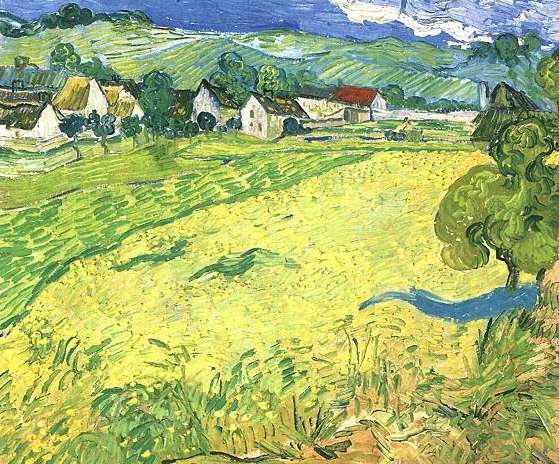
"During these last few weeks of his life, Van Gogh painted a few portraits but mainly a large number of landscapes among which is "Les Vessenots," the part of Auvers where Dr Gachet -the first owner of this painting- lived. The work is characteristic of Van Gogh's pictorial language at the end of his life, in which he combines very reduced and schematised compositions with a narrow palette of luminous greens and yellows and the use of agitated and nervous brushstrokes which follow a waving and repetitive rhythm."
One of the many works by artist friends that Dr. Gachet kept in disorderly piles in the rooms and corridors of his house was a painting by Armand Guillaumin of a woman naked to the waist, lying on a bed and holding a little Japanese fan. Vincent admired Guillaumin. He had visited his studio on the Quai d’Anjou, where once, to emphasize a point in an argument, he had undressed and fallen to his knees. Guillaumin had said that he looked like Delacroix’s “Tasso Among the Madmen” Dr. Gachet’s nude was unframed , and Vincent told him it was unforgivable to leave a masterpiece without a frame. Gachet promised to have one made by a local carpenter, who was slow delivering it.
Shortly after receiving Theo’s letter, Vincent, seeing the painting still unframed, stood dumbfounded in front of it, and then began shouting at Gachet, working himself up into an irrational fury until he was screaming unintelligibly in Dutch, pacing up and down the room. Suddenly he stopped and dug his right hand deep into the pocket of his trousers. Dr. Gachet, afraid that he was armed and remembering the time when he had attacked Gaugin with a razor, managed to remain calm and stared Vincent down until he skulked out of the room.
In forcing his friendship with Dr. Gachet to the breaking point, Vincent was following a familiar pattern. With Gaugin, he had forced a close friendship, then, without warning, and without reason, had attacked him. The result of this complicated process of guilt and unrealized aggression was that he had turned the violence against himself, cutting off his ear. Gachet’s reaction to Vincent’s outburst was like Gaugin’s; he avoided him.
Vincent’s next letter to Theo was distraught and partly incoherent: ” I myself am also trying to do as well as I can, but I will not conceal from you that I hardly dare count on being always in good health. And if my disease returns, you will forgive me.” He was warning Theo that his decline had already begun. “I still love art and life very much,” he went on, “but as for ever having a wife of my own, I have no great faith in that. I rather fear that toward say forty, or rather say nothing, I declare to know nothing, absolutely nothing as to what turn this may take.”
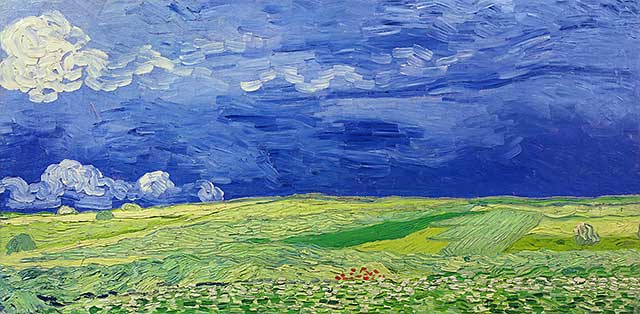
"Wheatfield Under Thunderclouds by Vincent van Gogh Vincent van Gogh completed Wheatfield Under Thunderclouds in the summer of 1890. In July, Vincent wrote to his mother and his sister Wil that he was painting a vast plain of wheat "as boundless as the sea." Van Gogh related the colors as a harmonious range of blue, white, pink, and violet, with the green and yellow wheat shining under a clear sky. Vincent van Gogh's own emotional state matched this tranquil subject: "I am in a mood of almost too much calmness, in the mood to paint this."
One wonders what prompted this sudden talk of marriage. Was Vincent thinking of Theo’s family situation, or were his thoughts prompted by Dr. Gachet’s daughter Marguerite? The last of visit of Theo uccured on the first Sunday in July. Theo had been quarreling with his employers and was afraid of losing his job,his child was ill, and Vincent was totally dependent on Theo. Was something said about the burden of supporting Vincent? The slightest hint, a random remark expressed in a moment of impatience, would have been enough to unsettle Vincent in his already nervous and sensitized state.
In his final letter Vincent once agained revealed his constant preoccupation: was Theo going to continue to support him, to send him fifty franc notes folded into his letters? And if he was, would Vincent not be diverting resources from his infant nephew and namesake? There was no solution.
In addition, could the medication given to Vincent have aggravated his state of disequilibrium? Counter to the digitalis-induced xanthopsia hypothesis, Doctor Gachet was well-known for his use and writings on the careful use of this drug. Gachet has been charged with mishandling van Gogh’s care by administering excessive doses of digitalis. Although Gachet was aware of the potency of the drug, administering large amounts of digitalis may have been the doctor’s only hope in treating a patient who was seemingly uncontrollable. In addition to any possible visual disorders, numerous other diagnoses of van Gogh’s general health have been suggested. These include mental disorders such as schizophrenia, bipolar disorder, neurosis, and epilepsy, as well as syphilis, gonorrhea, alcohol poisoning (from drinking dark absinthe), and sunstroke (diagnosed by Dr. Gachet).


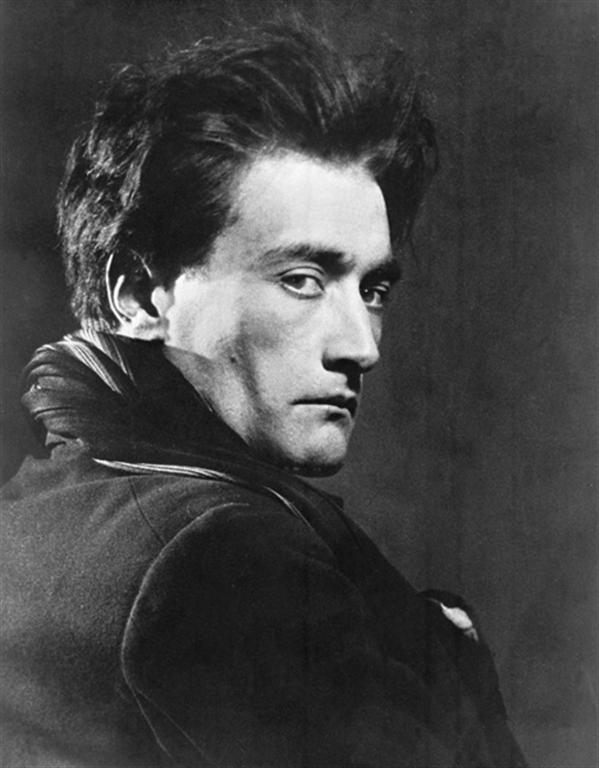
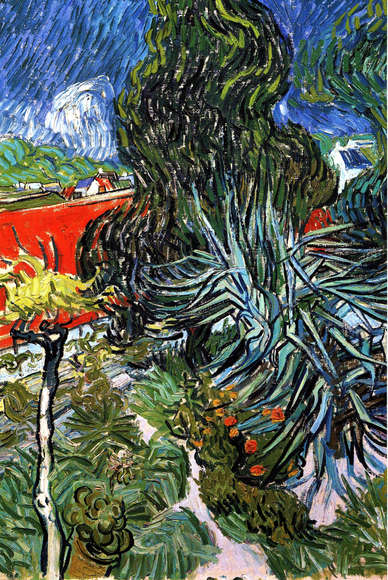
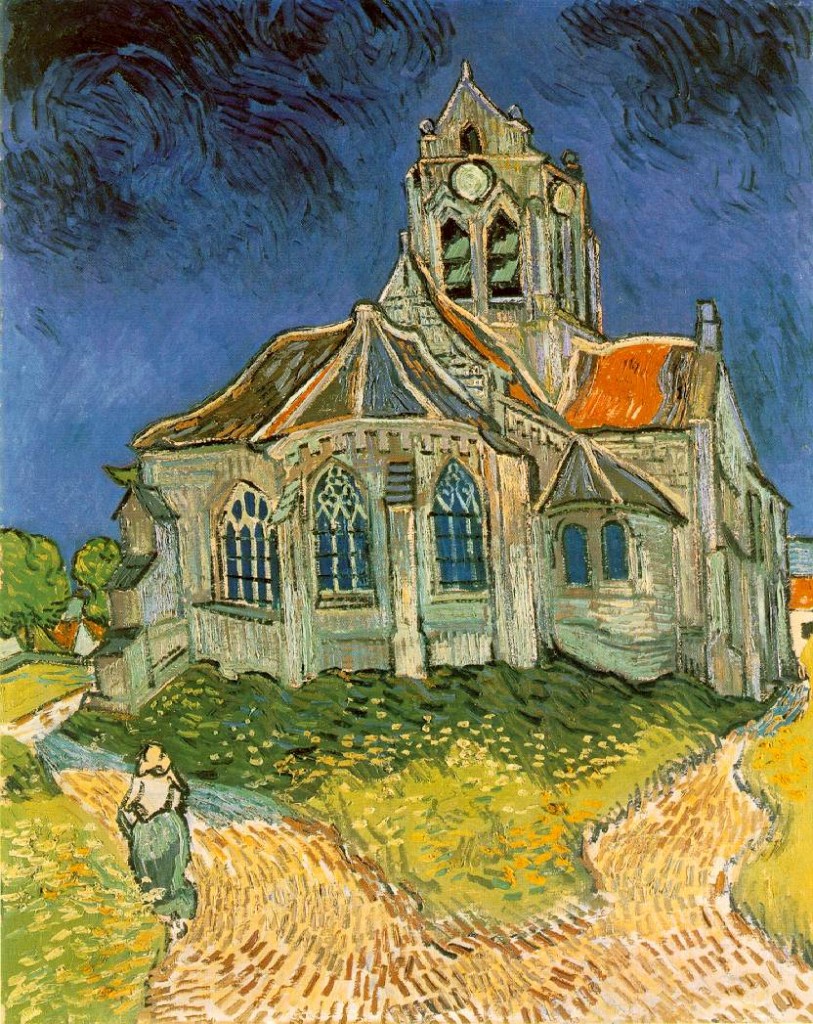



 COMMENTS
COMMENTS